NavSource Online: Aircraft Carrier Photo Archive
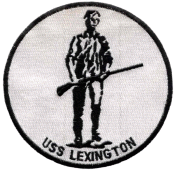
Courtesy of CAPT Gene Oleson, CHC, USN (Ret)
USS LEXINGTON (CV-2)
Flag Hoist/Radio Call Sign: November - Echo - Delta - Bravo

 |


|
| Lexington Class Aircraft Carrier | |||||
| Awarded | Laid down | Launched | Commissioned | Decommissioned | Stricken |
|---|---|---|---|---|---|
| (see below) | 8 Jan 1921 | 3 Oct 1925 | 14 Dec 1927 | 24 Jun 1942 | |
| Builder: Bethlehem Steel Corp., Fore River, Quincy, Mass. | |||||
 |
Fate: Torpedoed and bombed by Japanese carrier-based aircraft, 8 May 1942 (Battle of the Coral Sea) (read War Damage Report No. 16, located on the ibiblio.org website). Scuttled by USS Phelps (DD-360). A number of her crew were lost with the ship and remain on active duty. The wreck of Lexington was found, 4 March 2018, at the bottom of the Coral Sea, two miles below the surface and about 500 miles off the eastern coast of Australia, by billionaire-turned-explorer Paul Allen's R/V Petrel. |
| Click on Thumbnail for Full Size Image |
Size | Image Description | Source | |||||||||||
|---|---|---|---|---|---|---|---|---|---|---|---|---|---|---|
| Name |
||||||||||||||
 NS020281 |
94k | CV-2 was named to commemorate the events of 19 April 1775: Minutemen fought a detachment of British troops at Lexington, Mass., opening the Revolutionary War with the "shot heard round the world." Three previous American warships had borne the name: "The First Blow for Liberty." Battle of Lexington. Copy of print by Alexander Hay Ritchie after a drawing by Felix Octavius Carr Darley. Published in 1868. National Archives and Records Administration image 200(S)-JH-3. Map NS020281a courtesy of the National Park Service. |
NavSource | |||||||||||
 NS020281a |
113k | |||||||||||||
| Construction and Pre-War Years |
||||||||||||||
 NS020242 |
315k | Rear Admiral David W. Taylor, USN (left), Chief of the Bureau of Construction and Repair, and Rear Admiral John K. Robison, USN (right), Chief of the Bureau of Engineering, hold a model of the battle cruisers (CC-1 class) then under construction, 8 March 1922. In the foreground is a model of an aircraft carrier design converted from the battle cruiser hull. This photo illustrates the genesis of the Lexington-class aircraft carrier design. Standing in the background are (from left to right): Rear Admiral William A. Moffett, USN, Chief of the Bureau of Aeronautics; Congressman Frederick C. Hicks, of New York; Congressman Clark Burdick, of Rhode Island; and Congressman Philip D. Swing, of California. Photographed at the Navy Department by Harris & Ewing. Photograph from Department of the Navy collections in the U.S. National Archives and Records Administration (# 80-CF-395b). |
Naval History & Heritage Command | |||||||||||
NS020292 |
48k | Contract design for the Lexington and the Saratoga, 1922. The oval opening right aft is for twin torpedo tubes. Line drawing by A.D. Baker, III. Drawing and text from U.S. Aircraft Carriers: An Illustrated Design History, by Norman Friedman. |
Robert Hurst | |||||||||||
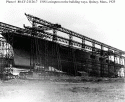 NS020211 |
138k | Lexington on the building ways at the Fore River Shipyard, Quincy, Massachusetts, shortly before her launching, circa late September or early October 1925. Taken by a photographer from Naval Air Station Lakehurst, New Jersey. Photograph from Department of the Navy collections in the U.S. National Archives (# 80-CF-21126-7). |
NHC | |||||||||||
 NS0202an |
4.63M | "ALL READY FOR A FEW AIRPLANES. The Navy's second huge aircraft carrier, the Lexington, ready for launching at the Fall River shipyards, Quincy, Mass., October 3. The craft will carry 72 airplanes—when the Navy gets the planes. Mrs. Robinson, wife of the Assistant Secretary of the Navy, will act as sponsor of the Lexington." The Evening Star, Washington, D.C., Wednesday, September 30, 1925. |
Library of Congress, Chronicling America, via Michael Mohl | |||||||||||
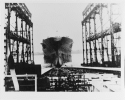 NS0202ay |
213k | Launching the future USS Lexington (CV-2) at Fore River Shipbuilding Corp., Quincy, Mass. Saturday, 3 October 1925. National Archives and Records Administration (NARA) photos. NS0202ay: Catalog # 80-CF-21126-4. NS0202aya: Catalog # 80-CF-21126-2. NS0202ayb: Catalog # 80-CF-21126-3. NS0202ayf: Vallejo Naval & Historical Museum photo. NS0202ayc: Catalog # 80-CF-21126-1. NS0202ayd: Catalog # 80-CF-21126-6. |
NARA, via Chadd Smith |
|||||||||||
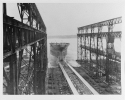 NS0202aya |
306k | |||||||||||||
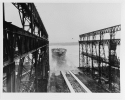 NS0202ayb |
271k | |||||||||||||
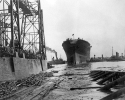 NS0202ayf |
520k | Darryl Baker | ||||||||||||
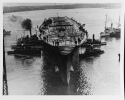 NS0202ayc |
254k | NARA, via Chadd Smith |
||||||||||||
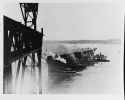 NS0202ayd |
175k | |||||||||||||
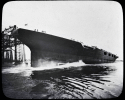 NS0202aye |
345k | Launching the future USS Lexington (CV-2). Courtesy of Thomas Crane Public Library. |
Via Bob Canchola, BT, USN (Ret.) | |||||||||||
 NS0202as |
1.87M | "Launch Huge Airplane Carrier; Has Speed of 39 Miles an Hour"
"Capable of a speed of 33 knots, nearly 39 miles an hour, the new airplane carrier Lexington of the United States Navy, launched yesterday at Quincy, Mass., is, with her sister ship, the Saratoga, the fastest of all warships save destroyers." "The Lexington, fourth ship in the United States Navy to bear that name, was built by the Bethlehem Shipbuilding Corporation at the Fore River Plant. Originally designed as a battle cruiser, she was changed to an airplane carrier under the Washington Conference agreements of 1922." "The vessel is 888 feet long, almost as large as the Berengaria, has a capacity for 70 airplanes and carries 8 8-inch guns and 12 5-inch anti-aircraft rifles. Her 190,000 horsepower exceeds the combined rated powers of the six battleships, New Mexico, California, Tennessee, Maryland, Colorado and West Virginia. She is electrically driven." The Brooklyn Daily Eagle, New York, Sunday, October 4, 1925. |
Jim McGovern | |||||||||||
 NS020274 |
48k | Lexington (CV-2) fitting out at the Bethlehem Steel Company shipyard, Quincy, Massachusetts. |
Paul Rebold | |||||||||||
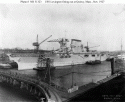 NS020245 |
93k | Lexington (CV-2) in the final states of fitting out, at the Bethlehem Steel Company shipyard, Quincy, Massachusetts, in November 1927. (Merchant ship partially visible at right is the S.S. West Grama, which served as USS West Grama (ID # 3794) in 1919.) U.S. Naval Historical Center Photograph (# NH 51323). |
Michael Mohl | |||||||||||
 NS0202aw |
1.02M | "Huge $39,000,000 Sea Fortress—Lexington, Greatest Ship of All Time, Ready to Ride Waves With Cargo of Airplanes" John explains: "[S]can of a newspaper clipping and photo regarding the USS Lexington CV-2 [...] I received if from my grandmother when she passed away. It shows CAPT (Louis) Shane, who was in overall charge of the construction of the Lexington CV-2, next to CAPT Marshall, who would be its first commander. Unfortunately the clipping does not say the name of the newspaper or have the date but given Commissioning was Dec 14, 1927, I presume it's between Dec 7 and 13, 1927. The entire article goes into how the Navy will accept the ship and it will be commissioned the next Wednesday. It's certainly from a local Boston or Quincy, MA newspaper because it speaks to the local residence of the area who have watched the ship grow over the years at the Quincy shipyard." |
John Shane, great grandson of CAPT Louis Shane | |||||||||||
NS020277 |
69k | "U.S.S. Lexington, Giant Navy Plane Carrier. A picture that Dave's father, Raymond Garner, purchased from an entrepreneurial photographer who was selling this photo to young seamen as they reported for duty aboard the Lex on the date shown in the photo. Because of the odd size of the photo (24" X 7.5"), Dave had to scan two images and put them together. Dave notes three things that stand out in this photo to make it unique:
|
Dave Garner | |||||||||||
 NS020277c |
195k | "USS Lexington sails into South Boston drydock," [10] January 1928. BPL accession # 08_06_022441. |
Courtesy of the Boston Public Library, ©Leslie Jones Collection | |||||||||||
 NS020277a |
593k | "Stern view of USS Lexington (CV-2) in Dry Dock 3 at the South Boston Annex, Boston Navy Yard, 10 January 1928. U.S. Navy photo, Boston National Historical Park Collection (NPS Cat. No. 11787)." |
Stephen P. Carlson, Preservation Specialist, Boston NHP, Charlestown Navy Yard |
|||||||||||
 NS020277b |
83k | "USS Lexington (CV-2) being settled in Dry Dock 3 at the South Boston Annex, Boston Navy Yard, 10 January 1928. U.S. Navy photo, Boston National Historical Park Collection (NPS Cat. No. 11787)." |
||||||||||||
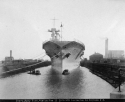 NS0202bj |
637k | USS Lexington (CV-2), bow view, in drydock #3 at Boston Navy Yard, 11 January 1928. National Archives and Records Administration (NARA) photo, # 19-LC-3260, Box 23. |
NARA | |||||||||||
 NS020299 |
135k | "Bow view of USS Lexington (CV-2) in Dry Dock 3 at the South Boston Annex, Boston Navy Yard, 12 January 1928. Steam-powered Portal Crane 50 is at left. U.S. Navy photo, Boston National Historical Park Collection (NPS Cat. No. 11787)." |
Stephen P. Carlson, Preservation Specialist, Boston NHP, Charlestown Navy Yard |
|||||||||||
 NS020299a |
78k | "View of port side of USS Lexington (CV-2) in Dry Dock 3 at the South Boston Annex, Boston Navy Yard, 12 January 1928. U.S. Navy photo, (Boston NY photo # 10676), Boston National Historical Park Collection (NPS Cat. No. 11787)." |
||||||||||||
 NS020286 |
143k | USS Lexington (CV-2) in South Boston drydock, January 1928. |
Courtesy of the Boston Public Library, ©Leslie Jones Collection | |||||||||||
 NS020287 |
81k | |||||||||||||
 NS0202ac |
190k | "USS Lexington in drydock," 18 January 1928. BPL accession # 08_06_022569. |
Courtesy of the Boston Public Library, ©Leslie Jones Collection | |||||||||||
 NS020298 |
52k | "DC-552298-MISSING NAVY FLYER.-Commander T[heodore] G[ordon] Ellyson, executive officer of the plane carrier USS Lexington and the Navy's senior flying officer, who took off with two companions from Hampton Roads, Va., Monday afternoon [27 February 1928] in an amphibian plane for Annapolis, Md., and has not been heard from since.-" "Photo shows Commander T.G. Ellyson.-" "Photo from Wide World Photos. Washington Bureau.-" |
Tommy Trampp | |||||||||||
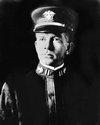 NS020298a |
78k | "CDR Theodore Gordon 'Spuds' Ellyson, the Executive Officer of the aircraft carrier Lexington and Senior Flying Officer, was killed on 27 February 1928, his 43rd birthday, in the crash of a Loening OL-7 aircraft in the lower Chesapeake Bay along with his crew while on a night flight from Norfolk, Virginia, to Annapolis, Maryland. His body washed ashore and was recovered in April 1928. He was buried in the Naval Academy Cemetery, in Annapolis." |
Bill Gonyo | |||||||||||
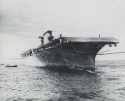 NS0202ba |
492k | USS Lexington (CV-2) in March 1928, during a nine-day scheduled visit to deliver aircraft to NAS Pensacola, Florida. The ship anchored eight miles out in the Gulf of Mexico because she could not enter Pensacola Bay. Lexington delivered seven T3M-1 bombers and six F6C-4 Curtiss Hawk fighters. At the time, she was the largest ship ever to sail the Gulf of Mexico. From the University of West Florida, I.D. - uwf_PF160_Item_043 (IID). |
David Upton | |||||||||||
 NS0202bo |
1.47M | Famous aviator Charles A. Lindbergh, who made the first non-stop flight from New York to Paris (20–21 May 1927) visits USS Lexington (CV-2). Exact date (15 April 1928?) and location (California?) unknown. Lexington's commanding officer, CAPT Albert W. Marshall, and executive officer, CDR Newton H. White, Jr. give Lindbergh a tour of the ship. |
Bob Canchola, BT, USN (Ret.) | |||||||||||
 NS020246 |
30k | Location and date unknown, pre-war image (poor). |
USN | |||||||||||
 NS0202bb |
259k | USS Lexington (CV-2) in dry dock at Hunters Point, California, apparently early in her career (late 1920s). At the time, Hunters Point was owned by Bethlehem Shipbuilding. (Thanks to Darryl Baker, who identified the location of this photo.) Courtesy of Gallica, Bibliothèque Nationale de France. |
Courtesy of Daniel Hacker, via Michael Mohl |
|||||||||||
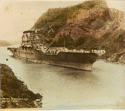 NS020209 |
179k | Passing through Culebra Cut, Panama Canal, (date unknown but, as deduced from the forward end of her flight deck, taken before her 1936 refit). |
From the collection of Joseph P. English. Contributed by his son, George E. English. | |||||||||||
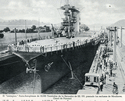 NS0202ab |
254k | "The Lexington, 33,000-ton airplane-carrier of the U.S. Fleet in the Miraflores Locks, Panama Canal," 1920s–mid-1930s. |
Richard Miller, BMCS, USNR (Ret.) | |||||||||||
 NS0202ae |
54k | "'A close squeeze.' U.S.S. Lexington. 33,000 ton aeroplane carrier, going through Miraflores Locks, Panama Canal." Color version of the photo above. |
Jim Ferguson. | |||||||||||
NS020203 |
62k | Overhead, underway, aircraft. Note shape of forward flight deck. | USN | |||||||||||
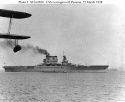 NS020216 |
75k | USS Lexington (CV-2) off Panama City, Panama, 25 March 1928, during her shakedown period. Collection of Franklin Moran, 1967. U.S. Naval Historical Center Photograph. (# NH 64500). |
NHC | |||||||||||
 NS020295 |
156k | NS020295: Battle Practice," circa 1928. Note VB-1B "Red Ripper" F6C in the foreground, and a Lexington-class carrier steaming in the background. NS020295a: Captain's inspection. NS020295b: T4M torpedo-bomber, VT-1B squadron, launching from USS Lexington (CV-2), circa 1928–1930. From the service photo album of Lance's grandfather, who served aboard Lexington until March 1931. |
Lance Kreisman | |||||||||||
 NS020295a |
1.36M | |||||||||||||
 NS020295b |
871k | |||||||||||||
 NS020213 |
112k | Curtiss F6C fighters (lower right) and Martin T3M torpedo planes on the carrier's flight deck, as she arrives off San Diego, California, on her maiden cruise, 4 April 1928. Note lowered elevator. U.S. Naval Historical Center Photograph. (# NH 51380). |
NHC | |||||||||||
| Album of ENS John Marcus Anderson | ||||||||||||||
Ensign Anderson was on the first cruise that took Lexington through the Panama Canal. There are no dates on the photos. |
||||||||||||||
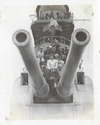 NS0202ad |
112k | Twin 8"/55 gun mount, No.3. |
Mary Anderson, granddaughter of ENS John Marcus Anderson | |||||||||||
 NS0202ada |
102k | Forward 8"/55 gun mounts, island, and stack block. |
||||||||||||
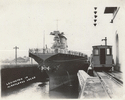 NS0202adb |
111k | USS Lexington (CV-2) in Miraflores Locks, Panama Canal. |
||||||||||||
 NS0202adc |
73k | RADM Joseph M. Reeves and CAPT (later RADM) Albert W. Marshall, first commanding officer of USS Lexington (CV-2). |
||||||||||||
 NS0202add |
105k | Vought UO-1 unarmed observation seaplane, # A-6994. |
||||||||||||
| Change of Command, 22 August 1928 | ||||||||||||||
Rear Admiral Joseph M. Reeves, Commander, Aircraft Squadrons, Battle Fleet, conducted a quarterly inspection of USS Lexington (CV-2) on Tuesday, 21 August 1928. The next day Captain Frank Berrien relieved the ship's skipper, the newly frocked Rear Admiral Albert W. Marshall, as Lexington's commanding officer. These photos were taken on the 22nd of August (some of them may have been taken on the 21st). |
||||||||||||||
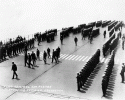 NS020278 |
144k | RADM Joseph M. Reeves inspecting crew of USS Lexington (CV-2). |
Vincent Egidio, son of Sisto Egidio, USS Lexington |
|||||||||||
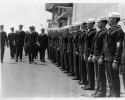 NS020278f |
119k | |||||||||||||
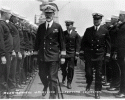 NS020278g |
124k | |||||||||||||
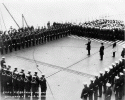 NS020278b |
163k | RADM Albert W. Marshall reading his orders. |
||||||||||||
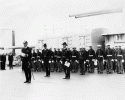 NS020278c |
107k | |||||||||||||
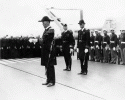 NS020278a |
104k | CAPT Frank D. Berrien reading his orders. |
Vincent Egidio, son of Sisto Egidio, USS Lexington |
|||||||||||
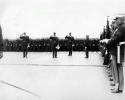 NS020278h |
92k | Left to right: RADM Albert W. Marshall, outgoing commanding officer; CAPT Frank D. Berrien, incoming commanding officer; CDR Newton H. White, executive officer. |
||||||||||||
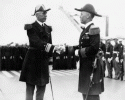 NS020278d |
101k | RADM Albert W. Marshall, outgoing Commanding Officer, and CAPT Frank D. Berrien, incoming Commanding Officer of USS Lexington (CV-2). |
||||||||||||
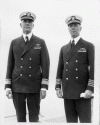 NS020278e |
101k | |||||||||||||
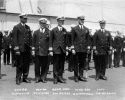 NS020278i |
137k | Left to right: CDR Newton H. White, Executive Officer, USS Lexington; CDR Eugene E. Wilson, staff of Commander, Aircraft Squadrons, Battle Fleet; RADM Joseph M. Reeves, Commander, Aircraft Squadrons, Battle Fleet; RADM Albert W. Marshall, Commander, Aircraft Squadrons, Scouting Fleet; and CAPT Frank D. Berrien, Commanding Officer, USS Lexington. |
||||||||||||
Crewmen of USS Lexington (CV-2). Date unknown (circa late 1920s).
|
||||||||||||||
 NS020367 |
414k | USS Lexington (CV-2), left, and USS Saratoga (CV-3), right, moored at Puget Sound Navy Yard, Bremerton, Washington, 22 September 1928. Note Sara had a walkway on the face of her stack—one of the few distinguishing features between these otherwise nearly identical twins. She did not have her distinctive black stripe on the funnel yet. This was added after their first Fleet Problem participation in January 1929.
|
Robert M. Cieri Darren Large |
|||||||||||
 NS020200 |
131k | USS Lexington (CV-2) early in her career (probably around 1928–29). |
Robert M. Cieri | |||||||||||
 NS0202ae |
112k | USS Lexington (CV-2) in the Pedro Miguel locks, just north of Miraflores, Panama Canal, headed for the Pacific (probably around 1928–29). |
Jim Sinnott, via Carol Edgemon Hipperson, author of "Radioman: An Eyewitness Account of Pearl Harbor and World War II in the Pacific." | |||||||||||
 NS020208 |
141k | Launching Martin T4M-1 torpedo planes, circa 1929. Naval History and Heritage Command (NHHC) photograph, # NH 82117 (Collection of LCDR Abraham DeSomer, donated by Myles DeSomer, 1975). |
NHHC | |||||||||||
 NS020256 |
87k | Perhaps during Fleet Problem IX, off Panama, January 1929. |
Edwin Kaukali | |||||||||||
 NS020276 |
111k | An early photo of USS Lexington (CV-2) at Panama, dated 22 February 1929, in full dress for George Washington's Birthday. Probably an official USN photo. |
Submitted by David Buell, from the collection of his sister, Benetta |
|||||||||||
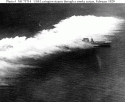 NS020218 |
93k | USS Lexington (CV-2) steams through an aircraft-deployed smoke screen, 26 February 1929, shortly after that year's "Fleet Problem" exercises. Courtesy of the Naval Historical Foundation, Washington, D.C. Collection of Admiral William V. Pratt. U.S. Naval Historical Center Photograph. (# NH 75714). |
NHC | |||||||||||
 NS0202be |
1.20M | USS Lexington (CV-2) underway. Date appears to be 28 May 1929. San Diego Air & Space Museum photo, Catalog #: SHIPS00206, John Armen Torigian Collection. |
Bob Canchola, BT, USN (Ret.) | |||||||||||
 NS020210 |
192k | USS Lexington (CV-2), top; USS Saratoga (CV-3), with her distinctive funnel stripe; and USS Langley (CV-1), accross the pier from Saratoga. Bremerton, Washington, 11 November 1929. |
From the collection of Joseph P. English. Contributed by his son, George E. English. | |||||||||||
 NS020210a |
1.34M | As above, cropped. |
Bob Canchola, BT, USN (Ret.) Robert Hurst. |
|||||||||||
 NS0203bh |
491k | The Navy's first three aircraft carriers docked at the Puget Sound Navy Yard, Bremerton, Washington, circa 1930 (approximately at the same time as the photo above). Ships are, from front: USS Langley (CV-1), USS Saratoga (CV-3), and USS Lexington (CV-2). Courtesy of Chief Photographer John L. Highfill, USN ret. Naval History & Heritage Command photo, # NH 95037 |
John Spivey | |||||||||||
 NS0202bd |
210k | Visitors aboard USS Lexington (CV-2) examining one of the ship's 8-inch forward twin gun mounts, 23 December 1929. The ship was moored in Tacoma, Washington, assisting the city by producing power. The Navy permitted some tours of the ship and these three ladies, Ethel Haasarud, Freda Gardner and Naomi Dykeman were judges in the City's upcoming Chamber of Commerce dance, to be held for Navy enlisted personnel on 26 December. |
Mike Green | |||||||||||
 NS020284 |
46k | Front view of the island of USS Lexington (CV-2), 1929–1933. From the collection of RADM Theodore R. Frederick. |
Edwin Kaukali | |||||||||||
 NS020247 |
65k | From 17 December 1929 to 16 January 1930 USS Lexington supplied electrical power to Tacoma, Washington, when this city suffered a power shortage. The electricity from the carrier totaled more than 4.25 million kilowatt-hours. Further reading at the Researcher @ Large website. |
Tracy White | |||||||||||
 NS020248 |
94k | |||||||||||||
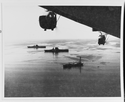 NS020243 |
543k | USS Los Angeles (ZR-3) flies over ships of the U.S. Fleet, circa 1930. Photographed from on board the airship, with two of her engine cars in the foreground. Ships below are USS Patoka (AO-9), closest to the camera, and the aircraft carriers Lexington (CV-2) and Saratoga (CV-3). Official U.S. Navy Photograph, now in the collections of the National Archives (# 80-G-462136). |
Hampton Roads Naval Museum | |||||||||||
 NS020288 |
117k | This is a 1930 photo of USS Lexington (CV-2), reportedly at Guantanamo Bay, Cuba. From the LT Howard Havens Photo Collection, now held by the Vallejo Naval and Historical Museum. |
Darryl Baker | |||||||||||
 NS0202bh |
1.54M | USS Lexington (CV-2) in Panama, June 1930. San Diego Air & Space Museum photo, ID 63591649, John Armen Torigian Collection. |
Bob Canchola, BT, USN (Ret.) | |||||||||||
 NS0202al |
97k | USS Lexington (CV-2) underway and launching aircraft, early-to-mid 1930s. |
Photos by CWO4 Cecil Wood USMC, contributed by his son Donald Wood | |||||||||||
 NS0202ala |
331k | |||||||||||||
 NS0202alb |
96k | |||||||||||||
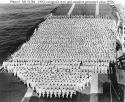 NS020215 |
183k | Ship's crew and personnel of her aircraft squadrons posed on the flight deck, circa the 1930s. View looks forward from atop her smokestack. U.S. Naval Historical Center Photograph. (# NH 51384). |
NHC | |||||||||||
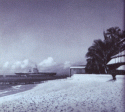 NS020263 |
74k | USS Lexington (CV-2) sailing past Waikiki Beach, Hawaii, circa early 1930s. |
Robert Hurst | |||||||||||
 NS0202at |
2.77M | "The plane carrier Lexington leads the way. A view along the sweeping deck of the carrier, with a column of battleships following in her wake off Panama." The Sunday Star, Washington, D.C., Sunday, 29 March 1931. |
Library of Congress, Chronicling America, via Michael Mohl | |||||||||||
 NS0202bi |
1.26M | "Uncle Sam's Sea-Going Airport—Her deck dotted with wasp-like fighting planes, the U.S. airship carrier Lexington is shown in this striking photo as she appears from the sky. There are 55 planes aboard her—count 'em. The big floating airport is seen moored in San Francisco Bay." Imperial Valley Press, El Centro, California, Thursday, 3 September 1931. |
Library of Congress, Chronicling America, via Michael Mohl | |||||||||||
 NS020296 |
131k | Boeing F3B-1s of Bombing Squadron 2 (VB-2B) in USS Lexington's hangar, seen from a lift well; Vought O2U Corsair observation floatplanes of Observation Squadron 3 (VS-3B) are stowed aft. Photo taken sometime between June 1931 and June 1933. US Navy photo. |
Robert Hurst | |||||||||||
 NS020159 |
194k | Ships of the United States Fleet pictured at anchor inside the breakwater at Colon, Canal Zone, 1933. Identifiable ships include the aircraft carriers Lexington (CV-2), Langley (CV-1), and Saratoga (CV-3), as well as the battleships Texas (BB-35) and New York (BB-34). Omaha-class and Pensacola-class cruisers are also visible. National Naval Aviation Museum (NNAM) photo (# 1996.488.001.006). |
NNAM | |||||||||||
 NS0202bm |
572k | "In Tribute To Captain King," The Observer of the U.S. Aircraft Carrier Lexington, vol. V, No.5, Bremerton, Washington, 31 May 1932. |
Jim Geldert | |||||||||||
 NS0202bg |
5.21M | United States Navy Magazine, 5 August 1933. "Lexington Wins Championship." |
||||||||||||
 NS0202bn |
8.60M | "Commander-in-Chief Special Edition," The Observer of the U.S.S. Lexington, vol. VI, No.46, San Pedro, California, 16 March 1934. |
||||||||||||
 NS0202bq |
1.32M | List of Ships Present—Gonaives, Haiti—16 May 1934. |
||||||||||||
 NS0202bk |
532k | "UNITED STATES FLEET" "Port au Prince, Haiti, "MEMO FOR ALL HANDS IN OFFICE:"
"SCHMIDT, H.A.A, CY(PA), US Navy, put this out the day before the Admiral's inspection and Tim countersigned the copies we brought into the office. Pretty good huh? Maybe you don't gather the full significance of the Memo, inasmuch as you do not know Schmidt personally." |
||||||||||||
 NS0202bl |
611k | "NAVY CREWS NICKNAME FLATTOPS" "Ever since the Navy put some planks on its old collier Jupiter
and renamed her the aircraft carrier Langley, Navy men have been giving
their ships nicknames. The Langley, appropriately enough, soon was dubbed the Covered Wagon. |
||||||||||||
 NS020264 |
153k | Three photos of USS Lexington (CV-2) taken before her 1935 refit at Puget Sound Navy Yard, as indicated by the absence of the four sponsons (two forward, two aft) installed to augment her anti-aircraft armament. | Robert M. Cieri David Buell |
|||||||||||
 NS020265 |
143k | David Buell | ||||||||||||
 NS020275 |
102k | Robert M. Cieri | ||||||||||||
 NS0202au |
128k | USS Lexington (CV-2). Pre-war postcard. |
Tommy Trampp | |||||||||||
 NS020260 |
65k | USS Lexington (CV-2) at anchor, location and date unknown (prior to her 1936–37 refit, as shown by the shape of the forward part of the flight deck). Note one of her fighters has just been launched. |
Robert Hurst | |||||||||||
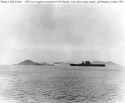 NS020244 |
85k | USS Los Angeles (ZR-3) (center distance) moored to USS Patoka (AO-9) off Panama during Fleet Problem XII, circa February 1931. USS Lexington (CV-2), at right, and a battleship are also present. Donation of Franklin Moran, 1967. U.S. Naval Historical Center Photograph (# NH 65300). |
NHC | |||||||||||
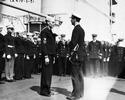 NS0202ai |
154k | Captain Ernest J. King, USN, presenting cigarette cases to race boat crew aboard USS Lexington (CV-2). King would later lead the U.S. Navy during WWII and become a five-star Fleet Admiral. Photographed on 5 September 1931. U.S. Navy photograph, now in the collections of the National Archives (NARA), # 80-G-699923. |
NARA, via Michael Mohl | |||||||||||
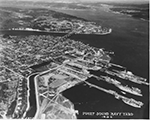 NS010532p |
638k | View of the U.S. Puget Sound Navy Yard, Bremerton, Washington, in 1932. Identifiable ships include (front to back): the crane ship Kearsarge (AB-1); (probably) a Tennessee-class battleship (BB 43–44), two Eagle-class patrol craft; USS Arkansas (BB-33); three Clemson/Wickes-class destroyers; and USS Lexington (CV-2). Photo i.d. via commons.wikimedia.org. National Archives Identifier: 6036984. |
Photo courtesy of catalog.archives.gov, via Michael Mohl |
|||||||||||
 NS0202ao |
112k | "Bi-planes on deck of aircraft carrier USS Lexington, March 1932." Leslie Jones Photograph Collection, Boston Public Library. |
Boston Public Library, via Michael Mohl | |||||||||||
NS020262 |
56k | USS Lexington (CV-2) at anchor at Lahaina Roads, Maui, February 16, 1932. |
Robert Hurst | |||||||||||
 NS020259 |
65k | USS Lexington (CV-2) underway, March 15, 1932. Note how closely the T4M torpedo-bombers and the smaller fighter and observation aircraft are packed together. |
Robert Hurst | |||||||||||
 NS0403432 |
1.26M | Puget Sound Navy Yard, Bremerton, Washington. The aircraft carriers USS Lexington (CV-2) and USS Saratoga (CV-3) at the yard. Photo appears to be dated 8 June 1932, but Saratoga was in Dry Dock #2 on that date. Also present is USS Jason (AV-2), an old collier converted into a seaplane tender, at left. The future USS Astoria (CA-34) is under construction in drydock, upper right. Photographed from a USAAC plane. (Thanks to David Stubblebine for providing additional information.) Naval History & Heritage Command (NHHC) photo (# NH 93556). |
NHHC, via Tom Bateman | |||||||||||
 NS020204 |
670k | Aerial, starboard beam. Aircraft on deck, Diamond Head in background. Dated 2 February 1933. National Archives and Records Administration (NARA) photo, # 80-G-416531. |
NARA | |||||||||||
 NS020205 |
616k | USS Lexington (CV-2) and USS Saratoga (CV-3) in front of Diamond Head. Regardless of what is printed on the picture, it must have been taken after 1933, when Saratoga's bridge was modified. [On July 1, 1932 Sara was berthed at Pier 6, Bremerton, WA.] |
Geoff Bell | |||||||||||
 NS0202aj |
95k | A Martin BM, of VT-1S, takes off over the stern of USS Lexington (CV-2), on 17 May 1934. Naval History & Heritage Command (NHHC) photo, # NH 51366. |
NHHC | |||||||||||
 NS020279 |
126k | Port bow view of USS Lexington (CV-2) underway, 31 May 1934, during a Presidential Review by President Roosevelt off New York City. US Navy and Marine Corps Museum/Naval Aviation Museum, Photo No. 1996.488.011.015. |
Mike Green | |||||||||||
 NS020350 |
105k | USS Lexington (CV-2), left, and USS Saratoga (CV-3) open to the public for viewing at New York City, June 1934. |
Photo from the collection of Edmund Cokely WO2, USN (Ret.) Submitted by his son-in-law, John Dupre' | |||||||||||
 NS0202aq |
269k | Another view, as above. |
Gerd Matthes, Germany | |||||||||||
 NS020289 |
134k | Three photos of USS Lexington (CV-2)—and her sister USS Saratoga (CV-3)—in New York harbor in June 1934. |
Eugene A. Brandner, AIA | |||||||||||
 NS020289a |
109k | |||||||||||||
 NS020289b |
104k | |||||||||||||
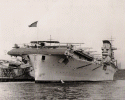 NS020285 |
400k | USS Lexington (CV-2) moored to West Fiftieth Street Dock, Hudson River, NY. A BM dive/torpedo bomber assigned to Torpedo Squadron One can be seen parked aft on the flight deck, which suggests a rough time frame of 1932–36. Moreover, USS Saratoga (CV-3) can be seen across the pier. Both Sara and Lex visited New York and were moored to Pier 90 (West Fiftieth Street Dock), June 1-19, 1934, after a Presidential Review. This photo was probably taken at that time. Photo by Edwin Levick. Edwin Levick Collection, Mariner's Museum. |
Jim Geldert | |||||||||||
 NS020285a |
151k | |||||||||||||
 NS020249 |
458k | Four photos of USS Lexington taken by Radioman 3C George W. Allen, circa 1935. Top: VS-3B Squadron insignia (Indian head in circle) is clearly visible on the biplane. |
RM3C George W. Allen, VS-3B, USS Lexington (CV-2), Jan. 1932-Dec. 1935. Submitted by his son, Russell G. Allen |
|||||||||||
 NS020250 |
436k | |||||||||||||
 NS020251 |
60k | |||||||||||||
 NS020252 |
67k | |||||||||||||
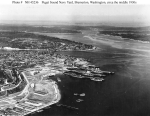 NS010558 |
112k | Puget Sound Navy Yard, Bremerton, Washington. Aerial photograph taken in the mid-1930s. Alongside the pier in center are the aircraft tender (ex-collier) Jason (AV-2), laid up in 1932 and sold in 1936, and the crane ship Kearsarge. Also present are the aircraft carriers Lexington (CV-2) and Saratoga (CV-3), the latter with her distinctive funnel stripe. U.S. Naval Historical Center Photograph (# NH 45236). |
NHC | |||||||||||
 NS020258 |
179k | USS Lexington underway circa 1936, showing her very wide funnel with its black top edge, under which the MG platform was situated. The 8in/55 twin mounts, and also the single 5in(127mm)/25s grouped in threes, are clearly visible. National Archives (NARA) photo (# 80-G-13048). |
Robert Hurst Larger copy submitted by Mike Green, Robert M. Cieri and Tommy Trampp |
|||||||||||
NS0202aa |
9.65M | "U.S.S. Lexington—CV2, Booklet of General Plans," 26 March 1936. Updated in 1937 and on 7 May 1941. |
Courtesy of the Historic Naval Ships Association | |||||||||||
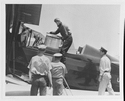 NS0202av |
183k | Rear Admiral Ernest J. King, USN, Chief of the Bureau of Aeronautics, arrives aboard USS Lexington (CV-2) in his new Curtiss SOC-1 aircraft, 2 June 1936. Note the plane's glossy blue flag color scheme. Official U.S. Navy Photograph, now in the collections of the National Archives and Records Administration (NARA), photo # 80-G-457421. |
Courtesy of Scott Koen & ussnewyork.com | |||||||||||
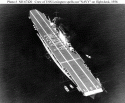 NS020217 |
92k | USS Lexington (CV-2) off Long Beach, California, 17 September 1936, with crewmembers spelling out "NAVY" on her flight deck. Courtesy of Commander Robert L. Ghormley, Jr., 1969. U.S. Naval Historical Center Photograph. (# NH 67420). |
NHC | |||||||||||
 NS0202ak |
48k | USS Lexington (CV-2), 8 October 1936, probably at the Coronado Roads, San Diego, California |
Paul Rebold | |||||||||||
 NS0202aka |
38k | |||||||||||||
 NS020257 |
99k | USS Lexington (CV-2) entering Puget Sound Navy Yard, date unknown—might have been taken in late 1936, as the machine gun sponsons (fore and aft) and platform (around funnel) are already in place, but forward flight deck has not yet been widened. |
Robert M. Cieri | |||||||||||
 NS020267 |
320k | USS Lexington (CV-2) at anchor, location unknown, after her 1936–37 refit, which widened her forward flight deck. |
Robert M. Cieri | |||||||||||
 NS0202ax |
440k | Another photo of USS Lexington (CV-2) at anchor in the late 1930s. Photographed by Geo. Winstead. |
Courtesy of Jim Kurrasch, Battleship Iowa, Pacific Battleship Center | |||||||||||
 NS020261 |
474k | USS Lexington (CV-2) underway sometime in the late 1930s (1937?), location unknown. Note the 0.5-in MG gallery below the funnel cap and the widened forward flight deck. |
Robert Hurst Larger copy submitted by Ed Zajkowski |
|||||||||||
 NS0202ap |
111k | Puget Sound Navy Yard, 26 March 1937, USS Lexington (CV-2) at the conclusion of a refit to widen her forward flight deck, as seen in this photo. Looking closely, it is possible to notice the lighter areas on the outside edges of the forward flight deck, where the additions to widen the deck were installed. |
David Buell | |||||||||||
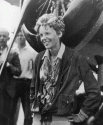 NS020282 |
179k | In July 1937 battleship USS Colorado (BB-45); aircraft carrier USS Lexington (CV-2); seaplane tender USS Swan (AVP-7): destroyers USS Lamson (DD-367), USS Cushing (DD-376), and USS Drayton (DD-366); and the U.S. Coast Guard Cutter Itasca searched in vain to locate Amelia Earhart (photo) after her disappearance in the middle Pacific (an area the size of Texas) during her around-the world flight. There has been much speculation about her disappearance over these past decades with a long list of theories, never substantiated, recorded over time on exactly what happened to Amelia and her navigator, Fred Noonan. |
Bill Gonyo | |||||||||||
 NS020282a |
1.75M | "Aircraft Carrier Lexington Joins Search—Rushing to the vicinity of Howland Island under forced draft the U.S.S. airplane carrier Lexington, one of the navy's fastest ships, is aiding in the search for Amelia Earhart and her navigator, Captain Fred J. Noonan, who were forced down on their round-the-world flight two weeks ago. The huge ship carries sixty-three planes and has released her brood near the area. Photo shows the Lexington pictured from the air. Note planes on the seagoing landing field." Daily Alaska Empire, Juneau, Alaska, Wednesday, 14 July 1937. |
Library of Congress, Chronicling America, via Michael Mohl | |||||||||||
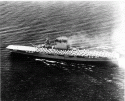 NS020280 |
193k | USS Lexington (CV-2) underway with aircraft spotted on deck, circa 1938. US Navy and Marine Corps Museum/Naval Aviation Museum, Photo No. 1996.488.011.020. |
Mike Green | |||||||||||
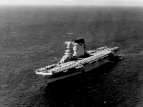 NS020201 |
259k | Aerial port bow view, with aircraft on deck, off Honolulu, TH, during Fleet Problem XIX, 8 April 1938. National Archives photo (# 80-G-410059). |
National Archives | |||||||||||
 NS020266 |
627k | Stern view of USS Lexington (CV-2) in the Panama Canal, possibly in the first half of 1939. |
Robert M. Cieri | |||||||||||
 NS0202af |
51k | "(WX9)NORFOLK, VA., APRIL 12[, 1939]—Plane Carriers Concentrate at Hampton—With the morning sun just breaking over the horizon of the Atlantic Ocean four of the Navy's giant plane carriers steamed into Hampton Roads today to take part in the greatest fleet concentration here since 1907. The ships are, left to right: the U.S.S. Lexington, Yorktown, Enterprise and Ranger. (See wire story)(AP wirephoto)(wrw41713wjf)39" |
Collection of Michael Strout, via Jonathan Eno |
|||||||||||
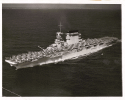 NS0202ag |
551k | "(WX12)NORFOLK, VA., APRIL 20[, 1939]—A Deckload of War Birds—The aircraft carrier Lexington of U.S. Navy carried a full deck load of planes when it left Hampton Roads this morning with other ships of the Pacific Fleet on the way back to West Coast. This airview shows the Lexington underway. (AP wirephoto)h51400the39 (see wire story)" |
Photo submitted by Robert M. Cieri, text by Jonathan Eno | |||||||||||
 NS020270 |
135k | USS Lexington (CV-2) in the Gaillard Cut, Panama Canal. There are monoplane TBD-1 Devastator torpedo-bombers parked aft on the flight deck; therefore, the photo was possibly taken in 1939, when Lexington was returning to the Pacific after Fleet Problem XX. |
Robert M. Cieri | |||||||||||
 NS020291 |
48k | "'1066-39' P.S.N.Y. [November 6, 1939] U.S.S. Lexington. Condition of plastic A.F. near stern and in way of rudder. Docked, Nov. 1939 — 12 months out of dock." Source: NARA San Francisco Mare Island Naval Shipyard General Correspondence Files 1941–46. |
Tracy White, Researcher @ Large | |||||||||||
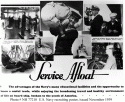 NS020268 |
120k | "Service Afloat," Navy recruiting poster issued in November 1939. It features photographs of USS Lexington (CV-2) and USS Dunlap (DD-384), as well as a pilothouse scene on a battleship and views of sailors splicing a hawser, carrying a hammock and sea bag, assisting a ship's navigator and standing engine room throttle watch. U.S. Naval Historical Center Photograph (# NH 77210), courtesy of the Naval Historical Foundation. |
NHC | |||||||||||
 NS014462u |
857k | USS Lexington (CV-2), left distance, with part of the Pacific Fleet in 1940 at Lahaina, Maui. It is possible that the battleship on the left is USS California (BB-44). The center battleship appears to be a Nevada class, either USS Nevada (BB-36) or USS Oklahoma (BB-37). The rightmost battleship is believed to be a Pennsylvania class, USS Pennsylvania (BB-38) rather than USS Arizona (BB-39). (See NS014462u for details.) |
Photo courtesy of Floyd Proffitt via Brad Proffitt | |||||||||||
 NS0202az |
3.15M | "LATEST OFFICIAL PICTURES OF OUR NAVY IN ACTION" "America's First Line of Defense As Streamlined As It Is Alert" "'V for Victory' is an old pattern for Navy flyers. This formation of a scouting squadron all based on airplane carrier Lexington when not aloft, seeking out forces of the enemy, America's naval force is admittedly the best in the world, both in men and planes." Detroit Sunday Times Pictorial Review, Sunday, 10 August 1941. |
Library of Congress, Chronicling America, via Michael Mohl | |||||||||||
 NS020212 |
699k | USS Lexington (CV-2) leaving San Diego, California, 14 October 1941. Planes parked on her flight deck include F2A-1 fighters (parked forward), SBD scout-bombers (amidships) and TBD-1 torpedo planes (aft). Note the false bow wave (Measure 5 camouflage) painted on her hull, forward, and badly chalked condition of the hull's camouflage paint (Measure 1). In this picture Lexington still retains her twin 8" mounts. Four 1.1" mounts have been installed, one on each quadrant, and a fifth mount between the bridge and the funnel. Atop each 8" mount is a gun tub containing two .50-cal mounts. Official U.S. Navy Photograph, now in the collections of the National Archives. (# 80-G-416362). (Thanks to Robert Hurst, who provided additional information). |
NHC Larger copy submitted by Bob Canchola, BT, USN (Ret.) |
|||||||||||
 NS020207 |
113k | Vertical aerial photograph of Ford Island, taken 10 November 1941, with five battleships tied up along "Battleship Row" at the top of the image. USS Lexington (CV-2), a seaplane tender and a light cruiser are moored on the island's other (northwestern) side. Approximately 21 PBY patrol planes are parked at the Naval Air Station's seaplane base, in the upper right. The bright diagonal line, at the lower left end of Ford Island, points to the north. Official U.S. Navy Photograph (NHC # 80-G-279385), now in the collections of the National Archives. |
Michael Mohl | |||||||||||

Official U.S. Navy Photograph, now in the collections of the National Archives. (# 80-G-416362). (Thanks to Robert Hurst, who provided additional information). |
NHC Larger copy submitted by Bob Canchola, BT, USN (Ret.) |
|||||||||||||
 NS020207 |
113k | Vertical aerial photograph of Ford Island, taken 10 November 1941, with five battleships tied up along "Battleship Row" at the top of the image. USS Lexington (CV-2), a seaplane tender and a light cruiser are moored on the island's other (northwestern) side. Approximately 21 PBY patrol planes are parked at the Naval Air Station's seaplane base, in the upper right. The bright diagonal line, at the lower left end of Ford Island, points to the north. Official U.S. Navy Photograph (NHC # 80-G-279385), now in the collections of the National Archives. |
Michael Mohl | |||||||||||
 NS0202ar |
79k | USS Lexington (CV-2), flagship of Task Force 12, underway in December 1941. Task Force 12 was sent to reinforce Midway on 5 December 1941 and after the attack on Pearl Harbor looked for the Japanese fleet until 13 December 1941. LIFE magazine, Bob Landry photographer, shared by Peter DeForest. |
Mike Green | |||||||||||
| Models & Memorabilia |
||||||||||||||
NS020269 |
28k | Model of USS Lexington (CV-2). |
Courtesy of Joel Rosen, Motion Models | |||||||||||
 NS020269a |
54k | |||||||||||||
 NS020273 |
98k | Model on display at the National Naval Aviation Museum, Pensacola, Florida. Photos taken on 13 June 2008. |
Photos by Judson Phillips | |||||||||||
 NS020273a |
76k | |||||||||||||
 NS0202bp |
358k | "Happy hour — on board the — U.S.S. Lexington —Captain Aubrey W. Fitch, U.S.N. Commanding — At Sea –Friday, 1 May, 1936 — on hangar deck at 1900" |
Ron Reeves | |||||||||||
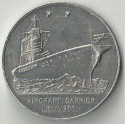 NS020290 |
20k | "Aircraft Carrier Lexington" "Navy Day — Washington Navy Yard — Oct. 27, 1936" |
Tommy Trampp | |||||||||||
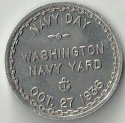 NS020290a |
21k | |||||||||||||
 NS020294 |
221k | "U.S. plane carrier Lexington at anchor off Long Beach, Calif." |
Arnold Putnam | |||||||||||
 NS0202bc |
404k | Survivor of USS Lexington Certificate for Robert James Allen. |
Eric Allen, for his father Robert James Allen | |||||||||||
|
||||||||||||||
| Crew Contact and Reunion Information | ||||||||||||||||
| U.S. Navy Memorial Foundation Fleet Reserve Association |
||||||||||||||||
|
| Related Links |
|
Hazegray & Underway World Aircraft Carrier Pages By Andrew Toppan War Damage Report No. 16, 8 May 1942 located on the HyperWar website CV-2 Lexington at the Researcher @ Large Website The First Aircraft Carriers Part One: The First American Flattops- Langley, Lexington and Saratoga, an article by Father Steve Dundas |
| Main Photo Index |
Aircraft Carrier Photo Index Page |
Comments, Suggestions or Image submissions, E-mail Carrier Information
Problems and site related matters, E-mail Webmaster
This page was created by Timothy Dike and is maintained by Fabio Peña
![]()
Last update: 1 April 2024